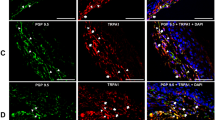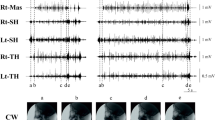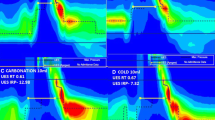Abstract
We examined the potential influence of cold stimulation of the anterior tonsillar pillars, before and after topical anesthesia, on the temporal linkage between the oral and pharyngeal components of the swallow. We hypothesized that if elicitation of the pharyngeal swallow were dependent upon stimulation of faucial mucosal receptors this response would be facilitated by cold tactile stimulation and inhibited by topical anesthesia. In 14 healthy volunteers undergoing simultaneous videoradiography and manometry we measured and compared regional transit and clearance times, and the timing of hyoid motion, upper esophageal sphincter relaxation, and opening within the swallow sequence. There was a significant, volume-dependent forward shift in timings of hyoid motion, upper esophageal sphincter (UES) relaxation profile, and opening which were influenced neither by cold stimulation nor topical anesthesia. Regional transit and clearance times and UES coordination were not influenced by cold stimulation. Pharyngeal clearance time was prolonged by tonsillar pillar anesthesia due to earlier arrival of the bolus head at this region (p=0.002). We conclude that the normal pharyngeal swallow response is neither facilitated nor inhibited by prior cold tactile stimulation or topical anesthesia to the tonsillar pillars, respectively. These observations do not support the hypothesis that elicitation of the pharyngeal swallow response is dependent upon stimulation of mucosal receptors in the tonsillar arches.
Similar content being viewed by others
References
Miller A: Deglutition. Physiol Rev 62:129–184, 1982
Pommerenke W: A study of sensory areas eliciting the swallow reflex. Am J Physiol 84:36–41, 1928
Miller F, Sherrington C: Some observations on the bucco-pharyngeal stage of reflex deglutition in the cat. Q J Exp Physiol 9:147–186, 1916
Sinclair W: Role of the pharyngeal plexus in initiation of swallowing. Am J Physiol 221(5):1260–1263, 1970
Miller A: Significance of sensory inflow to the swallowing reflex. Brain Res 43:147–159, 1972
Mansson I, Sandberg N: Salivary stimulus and swallowing reflex in man. Acta Otolaryngol 79:445–450, 1975
Cook IJ, Dodds WJ, Dantas RO, Kern MK, Massey BT, Shaker R, Hogan WJ: Timing of videofluoroscopic, manometric events, and bolus transit during the oral and pharyngeal phases of swallowing. Dysphagia 4:8–15, 1989
Dantas R, Kern M, Massey B, Dodds W, Kahrilas P, Brasseur J, Cook I, Lang I: Effect of swallowed bolus variables on oral and pharyngeal phases of swallowing. Am J Physiol 258(Gastrointest Liver Physiol 21):G675-G681, 1990
Jacob P, Kahrilas P, Logemann J, Shah V, Ha T: Upper esophageal sphincter opening and modulation during swallowing. Gastroenterology 97:1469–1478, 1989
Veis S, Logemann J: Swallowing disorders in persons with cerebrovascular accident. Arch Phys Med Rehabil 66:372–375, 1985
Lazzara G, Lazarus C, Logemann J: Impact of thermal stimulation on the triggering of the swallow reflex. Dysphagia 1:73–77, 1986
Cook IJ, Dodds WJ, Dantas RO, Massey B, Kern MK, Lang IM, Brasseur JG, Hogan WJ: Opening mechanisms of the human upper esophageal sphincter. Am J Physiol 257:G748-G759, 1989
Cook IJ, Gabb M, Panagopoulos V, Jamieson GG, Dodds WJ, Dent J, Shearman DJ: Pharyngeal (Zenker's) diverticulum is a disorder of upper esophageal sphincter opening. Gastroenterology 103:1229–1235, 1992
Logemann JA: Evaluation and Treatment of Swallowing Disorders. San Diego: College Hill Press, 1983
Kahrilas PJ, Dodds WJ, Dent J, Logemann JA, Shaker R: Upper esophageal sphincter function during deglutition. Gastroenterology 95:52–62, 1988
Bruning JL, Kintz BL: Computational Handbook of Statistics, 2nd ed. Illinois: Scott, Foresman and Co, 1977
Bucholz D, Bosma J, Donner M: Adaptation, compensation and decompensation of the pharyngeal swallow. Gastrointest Radiol 10:235–239, 1985
Linden P, Tippett D, Johnston J, Siebens A, French J: Bolus position at swallow onset in normal adults: preliminary observations. Dysphagia 4:146–150, 1989
Palmer J, Rudin N, Lara G, Crompton A: Coordination of mastication and swallowing. Dysphagia 7(4):187–200, 1992
Pansson I, Sandberg N: Oro-pharyngeal sensitivity and elicitation of swallowing in man. Acta Otolaryngol (Stockh) 79:140–145, 1975
Sinclair W: Initiation of reflex swallowing from the naso- and oropharynx. Am J Physiol 218(4):956–959, 1971
Storey A: Laryngeal initiation of swallowing. Exp Neurol 20:359–365, 1968
Doty R: Influence of stimulus pattern on reflex deglutition. Am J Physiol 66:142–151, 1951
Valdez D, Salapatek A, Niznik G, Linden R, Diamant N: Swallowing and upper esophageal sphincter contraction with transcranial magnetic-induced electrical stimulation. Am J Physiol 264(27):G213-G219, 1993
Doty RW: Neural organization of deglutition. In: Code CF, (ed.): Handbook of Physiology, Alimentary Canal, Sect 6, Vol 4. Washington DC: American Physiology Society, 1968, pp 1861–1902
Jean A, Car A: Inputs to the swallowing medullary neurones from the peripheral afferent fibers and the swallowing cortical area. Brain Res 178:567–572, 1979
Miller A, Bowman J: Precentral cortical modulation of mastication and swallowing. J Dent Res 56:1154–1159, 1977
Miller A: Characteristics of the swallowing reflex induced by peripheral nerve and brain stem stimulation. Exp Neurol 34:210–222, 1972
Car A, Jean A, Roman C: A pontine primary relay for ascending projections of the superior laryngeal nerve. Exp Brain Res 22:197–210, 1975
Sumi T: Role of reticular formation in the neural organization of deglutition. Jpn J Physiol 22:295–314, 1972
Jean A: Control of the central swallowing program by inputs from the peripheral receptors. A review. J Auton Nerv Syst 10:225–233, 1984
Ali G, Laundl T, Shaw D, de Carle D, Cook I: Are mucosal receptors important in the control of pharyngeal and UES function during swallowing? Gastroenterology 140:A469, 1993
Rosenbek J, Robbins J, Fishback B, Levine R: Effects of thermal application on dysphagia after stroke. J Speech Hear Res 34:1257–1268, 1991
Knauer C, Castell J, Dalton C, Nowak L, Castell D: Pharyngeal/upper esophageal sphincter pressure dynamics in humans: effects of pharmacologic agents and thermal stimulation. Dig Dis Sci 35:774–780, 1990
Yamamoto T, Yuyama N, Kawarmura Y: Cortical neurons responding to tactile, thermal and taste stimulations of the rat tongue. Brain Res 221:202–206, 1981
Calhoun K, Gibson B, Hartley L, Minton J, Hokanson J: Age-related changes in oral sensation. Laryngoscope 102:109–116, 1992
Sweazy R, Bradley R: Responses of neurons in lamb nucleus tractus solitarius to stimulation of the caudal oral cavity and epiglottis with different stimulus modalities. Brain Res 5480:133–150, 1989
Heimlich H: Rehabilitation after stroke. Ann Otol Rhinol Laryngol 92:357–359, 1983
Miglieta O: Evaluation of cold in spasticity. Am J Phys Med 41:148–151, 1962
Olsen J, Stravano V: A review of cryotherapy. Phys Ther 51(8):840–853, 1972
Bawa P, Mekjavic I, Calanicie B: Effect of core cooling on short and long latency response. Brain Res 264:320–322, 1983
Christensen L, Mohamed S: Effects of topical cooling on isometric contraction of the human masseter muscle. Arch Oral Biol 29(8):635–639, 1984
Barnes W: Effects of heat and cold application on isometric muscular strength. Percept Mot Skills 56:886, 1983
Kuehn D, Templeton P, Maynard J: Muscle spindles in the velopharyngeal musculature of humans. J Speech Hear Res 33:488–493, 1990
Liss J: Muscle spindles in the human levator veli palatini and palatoglossus muscle. J Speech Hear Res 33:736–746, 1990
Author information
Authors and Affiliations
Rights and permissions
About this article
Cite this article
Ali, G.N., Laundl, T.M., Wallace, K.L. et al. Influence of cold stimulation on the normal pharyngeal swallow response. Dysphagia 11, 2–8 (1996). https://doi.org/10.1007/BF00385791
Issue Date:
DOI: https://doi.org/10.1007/BF00385791




